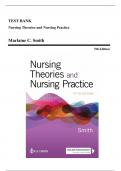Exam (elaborations)
Test Bank - Nursing Theories and Nursing Practice, 5th Edition (Smith, 2020), Chapter 1-33 | All Chapters
- Course
- Institution
- Book
Test Bank - Nursing Theories and Nursing Practice, 5th Edition (Smith, 2020), Chapter 1-33 | All Chapters
[Show more]




